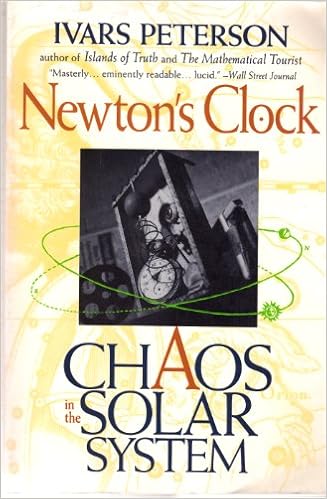
Newton’s Clock: Chaos in the Solar System
Ivars Peterson
W.H.Freeman and Company, New York
ISBN 0-717-2396-4
QB351.P48 1993
Rating: 5 of 5 This book gave me a new appreciation for difficulty of the many-body problem, and what insights are possible. It gave me a new respect for those people who pursue those difficult problems.
One of the opportunities I have during retirement is to revisit my library, to reread books I have enjoyed in the past, and to read some of the books I bought, but never got around to reading. This is one of those books I’ve had for a long time, possibly over 20 years, but never read. Now I wish I had read it much earlier. I’d like to have read it while in graduate school. However it was not yet available, indeed much of the work discussed, had not been accomplished yet.
In school, we dealt primarily with problems that had relatively simple, closed form solutions. Steady state solutions are studied much more than dynamic systems. Constraints on systems tend to make them more solvable. The two body gravitational (inverse squared) field is one of those. The motion solutions take the form of conic sections: ellipses, parabolas, hyperbolas. Initial conditions result in unique solutions. Bound problems have repetitious, periodic solutions. Introduce a third body, or even a body with volume, and most bets are off (though I think energy is still conserved). The solar system is one of those difficult problems. The advent of computers made many calculations easier, though complicated arithmetic problems have been worked at least back to the time of Kepler, who traced the two dimensional paths of planets through the sky onto a three dimensional framework of the solar system, to develop Kepler’s laws. The annoyance is that when calculations are compared to observations over long periods of time, they tend diverge, limiting the usefulness computational predictions.
The simple example is a two part pendulum. A simple pendulum has a simple reproducible periodic solution, and indeed, it is useful for timekeeping. Add a second arm and near chaos results. Sometimes the arms swing together, sometimes they are opposed, and it is even possible for one arm do be doing loop-the-loops.
Peterson begins his story with cultural Greek efforts to plot and predict planet motions through the sky. On annual timescales their paths tend to be periodic projected on the starry background. Kepler transformed the circle, and epicycle based system to an ellipse based system. He also introduced descriptions of planet speed throughout those orbits. Newton added the inverse square law that gave a reason for those eliptical orbits, and provided a way to describe interactions between the planets. Discrepancies between calculations and observations presented challenges to Newton’s theory, but his development of a perturbation theory helped address some of these.
An important success of Newton’s theory was the discovery of Neptune from the discrepancies between calculations of Uranus orbit and the observed position.
The late 19th century question of the long term stability of the Solar System lead to Poincure’s analysis of position and velocity phase space to look for confined, stable regions, and diverging, unstable regions. One might look at an array of (x.v) points and follow them to (x+δx, v+δv). One can ask questions like are these new points closer together or further away from nearby points? Do the streamlines of these trajectories come back on themselves, or or do they diverge? This approach comes up with regions of stability and instability, even though the trajectories themselves may not appear to be well defined.
Modern (1990’s) approaches have looked at solar system planetary orbit evolution out several million years. While one would think this should yield a unique solution, running them backward from a solution does not yield the correct starting point. This is generally attributed to use of numerical approximations. These investigations suggest disruptions could occur on 5 million year time scales, but that these are not drastic. It is not just numerical approximations hat can cause problems. These models include a subset of the solar system, just inner planets, or just outer planets. I don’t think they include the small perturbations of asteroids and comet. So the ambiguity of results may not simply be an artifact of numerical processing.
The discovery of extra-solar planetary systems, since this book was published, presented opportunities to test ideas about planetary system stability. While I’m sure these have been done, I’m not sure of the results. Some of the compact, multiple heavy planet systems sound like they could be challenging to understand.
As an aside, it seems to me that the search for stability in multi-system models might be useful to apply in the study climate stability. While simplifications of of the solar system are used run out long term predictive studies, the base premise is that a complete many-body interaction model is the goal. The relevance for climate studies is that climate models may not be divorced from weather models. While the periodicity of planetary orbits make it tempting to gloss over individual planet behavior, it has to be done with caution and skepticism. It is probably at least as difficult to project climate predictions, when next months weather cannot predict nearly as accurately as next months planetary configuration.
I recommend reading this book for those who have an interest is history of science, astronomy, orbital mechanics, or chaos theory. It is not extremely mathematical. Using a historical approach helps give a flavor for the field.
